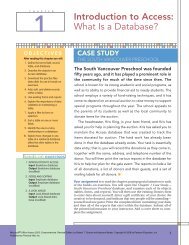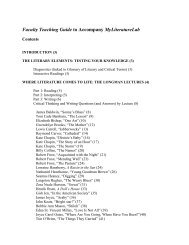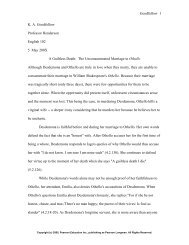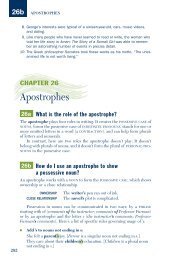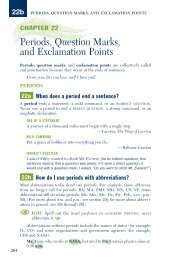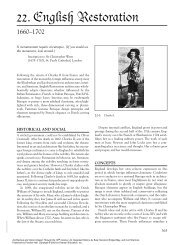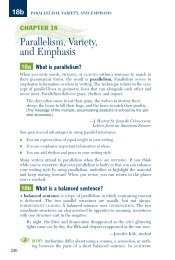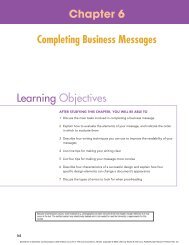Chapter 41: Word Order eBook
Chapter 41: Word Order eBook
Chapter 41: Word Order eBook
You also want an ePaper? Increase the reach of your titles
YUMPU automatically turns print PDFs into web optimized ePapers that Google loves.
How can I recognize prepositions?<br />
42a<br />
4. The whales first to arrive are sighted sometime in late November, after<br />
completing a 3,000-mile journey.<br />
5. The humpbacks last to migrate to Hawaii arrive by December late or<br />
January early.<br />
EXERCISE <strong>41</strong>-2 Consulting all sections of this chapter, find and correct<br />
any errors in word order.<br />
1. A beautiful few flowers began to bloom in my garden this week.<br />
2. A neighbor asked me, “You did grow all these yourself?”<br />
3. “Yes,” I replied, “the roses are my favorite husband’s, but the tulips are my<br />
favorite.”<br />
4. My neighbor, who extremely was impressed with my gardening efforts,<br />
decided to grow some flowers of her own.<br />
5. Weeks later, as I strolled by her house, I saw her planting happily seeds<br />
from her favorite type of plant—petunias.<br />
CHAPTER 42<br />
Prepositions<br />
Prepositions function with other words in PREPOSITIONAL PHRASES (7n).<br />
Prepositional phrases usually indicate where (direction or location), how (by<br />
what means or in what way), or when (at what time or how long) about the<br />
words they modify.<br />
This chapter can help you with several uses of prepositions, which function<br />
in combination with other words in ways that are often idiomatic—that<br />
is, peculiar to the language. The meaning of an IDIOM differs from the literal<br />
meaning of each individual word. For example, the word break usually refers<br />
to shattering, but the sentence Yao-Ming broke into a smile means that a<br />
smile appeared on Yao-Ming’s face. Knowing which preposition to use in a<br />
specific context takes much experience in reading, listening to, and speaking<br />
the language. A dictionary such as the Longman Dictionary of Contemporary<br />
English or the Oxford Advanced Learner’s Dictionary can be especially<br />
helpful when you need to find the correct preposition to use in cases not<br />
covered by this chapter.<br />
42a<br />
How can I recognize prepositions?<br />
Box 42-1 on the next page lists many common prepositions.<br />
509





